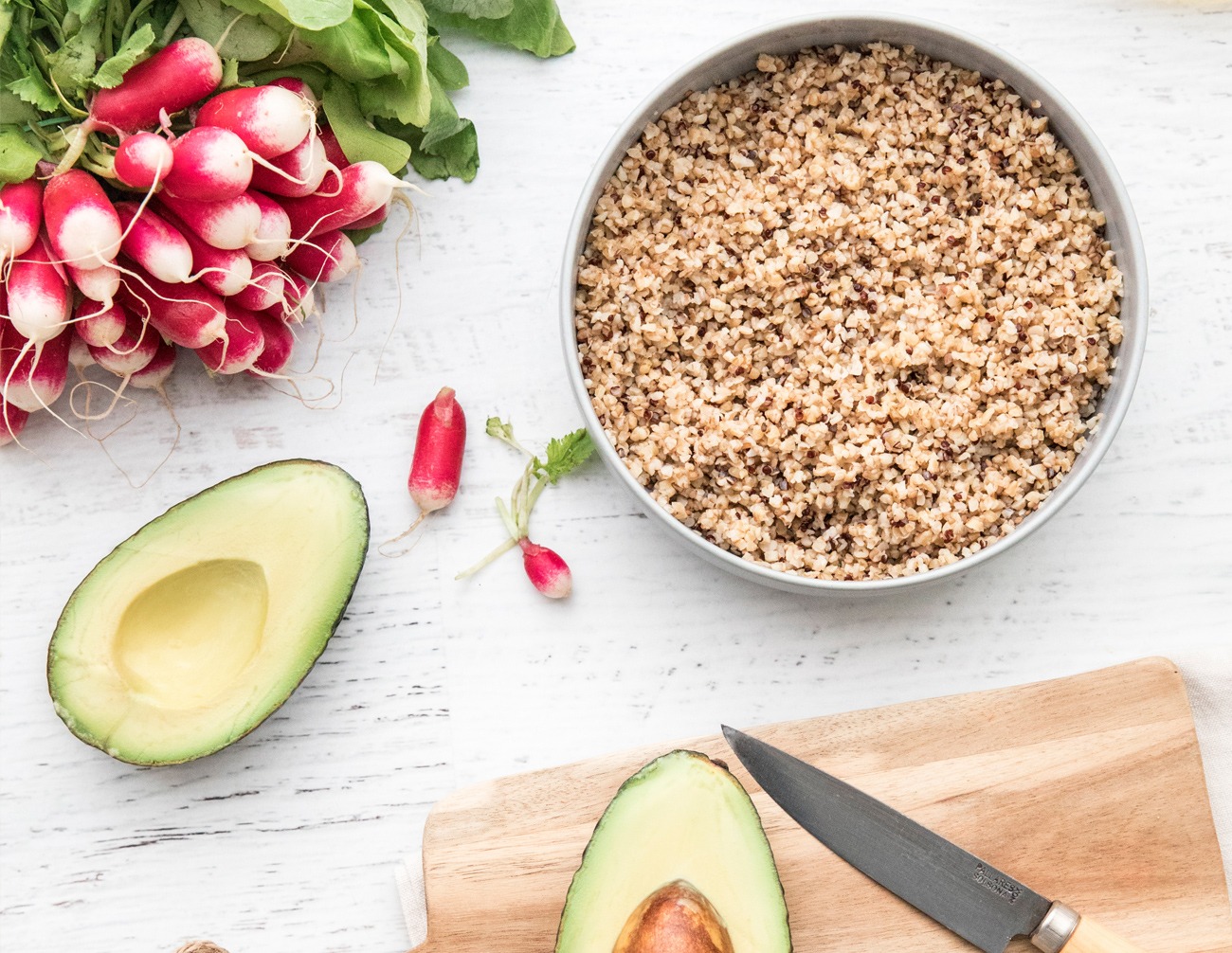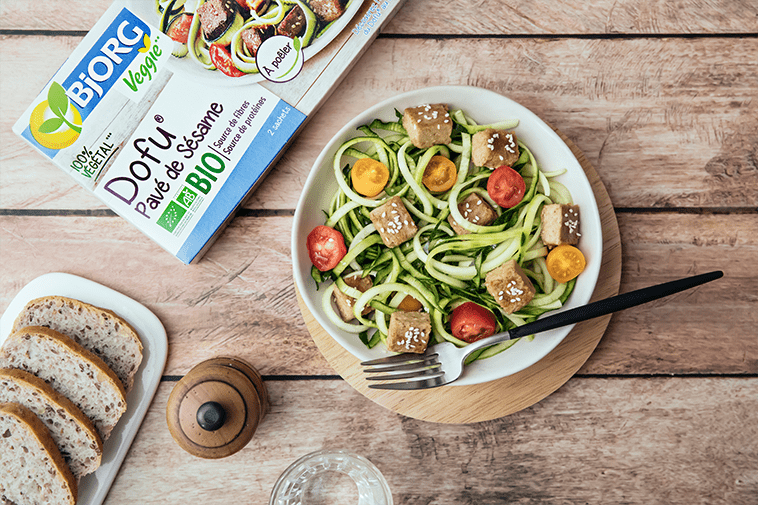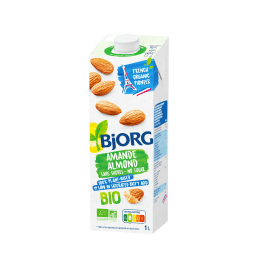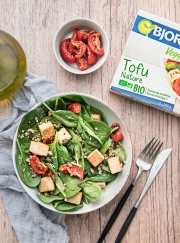
Nutrition is a complex subject because our food choices are too often guided by our taste buds who tend to lose the sense of true taste. Hence the mistakes they drive us to make when it comes to choosing the foods in our plate.
In order to see things more clearly, we asked our naturopath chief to help us define the golden rules to return to a healthy diet, fitness weight and better health…
We should not forget to add to these advices the essential notion of pleasure found in what we eat. Avoid sad and harsh diets in favour of a tasty, balanced and organic diet.
Let your food be your medicine.
Hippocrates, father of traditional medicine
1. Moderate yourself!

Food, however healthy but taken in too large a quantity, can disrupt the digestive system. Digestion is then laborious, which contributes to the fatigue of our body.
To avoid the trap of overly plentiful meals, here are some tips:
- Eating slowly makes you feel more full. The more satisfying a meal is taste wise, the less we want a second plate or snack afterwards
- Avoid preparing more than you need. Indeed, rather than keeping or throwing away leftovers, one will be tempted to eat it whereas one is already satisfied.
- Moderate in volume one of the three meals and preferably the evening meal.
- Harmoniously spread the food rations over the day: in nutrition, what comes first is the middle ground and regularity.
The common mistake to avoid:
Forgetting breakfast and only starting to eat around noon often results in afternoon snacks and overly plentiful dinners in the evening.
2. Choose the foods carefully.
The refining process alters the nutrient content of staple foods and depletes them by eliminating nutrients (vitamins, trace elements, unsaturated fatty acids).
The main objective is to make the food more stable, which thus keeps it fresh for a longer period of time. Unrefined food should therefore be encouraged.

But just because a food is organic doesn’t mean you have to buy it with your eyes closed. Read the labels carefully and be careful about freshness, country of origin and ingredient list.
Indeed, it is often the taste and the origin of the plants that testify to their quality and nutritional value.
3. Cook healthy.
Eating healthily also means taking the time to cook.
Good nutritional behaviours and know-how in culinary methods are also very important. For example, when it comes to different types of cooking, it is important to avoid steaming everything and exclusively without fat.
Don’t hesitate to rotate between the oven, smothered version, braised with a little bit of Organic Extra Virgin Olive Oil,steamed, but avoid frying. Consider introducing fresh or dried herbs and sweet spices into your recipes for their flavours and nutritional qualities.

4. Alternate raw and cooked vegetables.

- Raw and cooked vegetables should be present at each meal, alternately, at lunch and dinner. In particular, they provide vitamins and minerals.
- Raw vegetables make the digestion easier through their enzymes.
- Fibre helps regulate transit.
- Avoid eating salads in plastic bags that have already been washed, canned vegetables, and always take the time to read the labels. If you don’t have fresh products, consider frozen plain vegetables.
- Prefer fresh seasonal fruit (1 to 2 per day).
5. Take the time to eat.
Time is often what we miss the most, and yet it is what conditions the digestion and assimilation of the meal. Chewing is crucial. It allows food to be soaked in saliva and thus begin digestion. It also helps to lighten the work of the stomach by starting the breakdown of carbohydrates and grinding food.
Taking the time to chew allows our senses to have fun, to refine our palate, to work our taste. It’s still the best way to sort out and choose the best for us.
And sometimes, rather than mechanically eating, why not behave like a food critic and wondering if the bite we swallow deserves us to take the next one!
6. Combine food correctly.

It is enough to know the principle of food associations by having as a reference point proteins, whether of animal or vegetable origin, which will be supplemented by carbohydrates, fats, fibres (vegetables, fruits) in order to give a large place to the plant.
When eating an animal protein-centric meal such as fish or meat, choose raw and cooked vegetables and a small serving of carbohydrates such as pasta, potatoes, rice and other cereals as a side.
Thus a fish will be primarily accompanied by a vegetable and in addition to a small amount of rice or a piece of bread. The same goes for a meal with meat.
You can also go for a balanced plant-based protein meal, combining cereals and legumes, always with a serving of raw or cooked vegetables.
Some landmarks:
- Avoid mixing several animal proteins during the same meal. For example, fish or poultry or meat + cheese + dessert containing eggs.
- Avoid systematically finishing the meal with sugar-concentrated desserts such as flavoured milk creams, dessert creams, ice creams, overly sweet fruit yoghurts: choose a simple fruit from time to time.
- This does not mean that desserts should be removed. It is enough to know how to choose them and even better, to learn how to make delicious sweets.
- Finally, during meals combining cereals and legumes, be sure to respect the proportions of about 2/3 of cereals per 1/3 of legumes.
7. Evitez le grignotage.
This bad habit is often adopted from childhood. As parents, we have a real responsibility to protect our children from the habit of untimely snacking.
A healthy mid-afternoon snack (fruit, dairy and cereals), and possibly a lighter mid-morning snack, is recommended for children for whom snack time is a “real” meal.
8. Diversify protein intakes.
Plant-based protein consumption has declined sharply over the past 50 years in favour of meat and dairy products. Plant-based protein is mainly defined as cereals and legumes. Nowadays they are mainly eaten as sides to our meat dishes.
However, their association within the same meal can be a real alternative to meat, an alternative devoid of saturated fats and providing fibre, minerals and vitamins.
- Three types of consistent meals.
The unit of measurement being the week, alternate vegetarian and non-vegetarian meals. In order to familiarize yourself and your family with these meals, invest yourself in the culinary learning of these foods, because it is your know-how that will make them tasty and digestible.
- Traditional meals:
- based on animal protein, combined with unrefined cereals or tubers
- vegetables and fruits
- Mixed meals:
- that combine a little bit of animal protein with an unrefined cereal or legume, vegetables and fruits
- Vegetarian meals:
- that combine an unrefined cereal and a legume with vegetables and fruits. Best nutrition/price ratio!
9. Select your oils carefully.
All oils that are refined, discoloured or deodorized by chemical techniques should be avoided. These successive treatments make them less interesting.

Prenez l’habitude d’utiliser l’Huile d’Olive Vierge Extra Bio que ce soit pour la cuisson ou pour les assaisonnements, mais aussi les autres huiles bio telles que colza, sésame, noix pour tous les assaisonnements à cru.
These oils contain mono and poly unsaturated fatty acids essential to our health.
Ces bons acides gras sont également présents dans les fruits oléagineux que l’on introduira sous forme entière dans un muesli le matin par exemple (noix, noisettes, amandes, pépins de courges, graines de tournesol) ou sous forme de purée d’oléagineux dont les plus courantes sont l’amande et la noisette qui remplaceront le beurre sur une tartine ou dans un gâteau.
10. Learn how to distribute carbohydrates.
The ideal distribution of carbohydrates in the diet is as follows:
- 90 % of complex carbohydrates such as: unrefined cereals, semi-whole pasta, wholemeal or semi-whole sourdough bread, potatoes, legumes, green vegetables, oilseed fruits, fresh fruits, dairy.

- 10 % of simple carbohydrates (sugars) such as: desserts, honey, jams, brown cane sugar, agave syrup…
Knowing that carbohydrates account for 55% of our daily food ration, it is important to know how to choose them and overall to focus on complex carbohydrates.
This carbohydrate balance is important especially during breakfast in order to avoid tiredness and reaction cravings that can drive us to the candy dispenser and the coffee machine.
11. Choose sea salt.
There are several types of salt, which are differentiated according to their origin.

- Sea salt is usually harvested from salt marshes on the coasts of the Atlantic Ocean (grey salt) or the Mediterranean Sea (naturally white salt). It is obtained by evaporation of salt water.
- Gem salt is extracted from salt mines (fossil marine deposits), far from the coast. The refined white salt found in shops is often gem salt.
- Salt from saltwater sources,inside continents: it is extracted through heat, by evaporation of water.
The main advantage of sea salt is that in addition to the sodium chloride (NaCl) to which it owes its role as a taste enhancer, it contains more minerals and trace elements, provided it is not refined.







